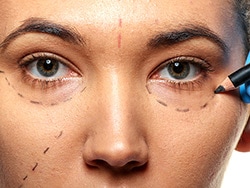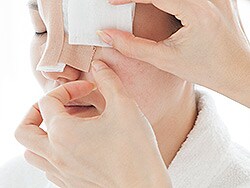A recent trend shows that not only are patients undergoing plastic surgery getting younger, the number of teenagers seeking plastic surgery is growing.[1,2] What kinds of procedures are common among teenagers? When should we say “yes” to teens having plastic surgery? The answer is not always so simple.
Noninvasive Procedures
Recent statistics indicate that cosmetic and plastic surgery procedures among teens are on the rise, but this trend is not necessarily alarming.[1,2] Common procedures that teens ask for include noninvasive skin procedures such as microdermabrasion, chemical peels, and laser skin resurfacing, primarily for the treatment of acne scarring. These types of procedures help to make acne scars and skin discolorations less obvious and can improve the overall appearance of the skin. They always should be performed under the care of a qualified, board-certified plastic surgeon or dermatologist.

Over the past 5 years, dermal fillers have also made a significant impact in how faces and lips are augmented in teenagers and adults. Teens have seen their Hollywood idols get overdone lips and cheeks and have followed suit. Unfortunately, many of these adolescents have been misguided by the social media about these teen “role models.” A high majority of board-certified plastic surgeons are recommending against the use of cosmetic dermal facial fillers and Botox during the teenage years, when tremendous physical and psychological growth is occurring. The rationale that fillers and Botox can have a positive effect and can be used as a form of “prejuvenation” to prevent aging is significantly misguided and has absolutely no scientific basis.
Perspective on Plastic Surgery Procedures
Plastic surgery procedures for adolescents need to be put into the proper medical perspective during these critical years of psychological, social, and developmental growth.[2,3,4,5] Plastic surgeons are physicians first and foremost and must “do no harm.”
Breast enhancements are popular but cannot and should not be performed on patients younger than 18 years. The US Food and Drug Administration recommends the use of saline instead of silicone implants in patients 18-22 years of age, unless the patient has a significant congenital breast deformity or asymmetry after completing their final growth spurt at age 18 or later.
Not infrequently, teens seek breast reductions because of peer ridicule, bullying at school, and back pain.[3,4,5] This is a reasonable request and has significant psychological and physical advantages; however, the tradeoff for smaller breasts is having a scar around the breast. The plastic surgeon must discuss this in detail with the parents and the patient.
Male breast reduction procedures for gynecomastia are also growing in demand for young boys. Gynecomastia, or the growth of male breast tissue, is considered the “silent male disease” and may be caused by medication side effects, obesity, or other reasons. As boys fully mature and slim down, the breasts may decrease in size without intervention; however, in severe cases, teenage boys may benefit from surgical attention to blunt the emotional impact of excessive breast tissue. In some cases, this can be done via minimally invasive techniques using ultrasonic liposuction.[6]
Otoplasty is a procedure that is commonly performed to reshape and correct prominent ears. It can be done during the teen years and even as early as age 6 or 7 years, when the ears are nearly adult-size, particularly if a child is being ridiculed at school.[7]
The nose is also a common subject of teasing and bullying in school-age children and teens. Surgical nose reshaping, or rhinoplasty, is also commonly performed and can often result in dramatic physical and psychological improvements for minors, especially teenage girls.
Guiding Factors for Plastic Surgery in Minors
Some parents are continuing to give plastic surgery as a “gift” for graduation or other occasions, which is generally considered a bad idea. Over the past several years, upticks in plastic surgery rates in teenagers may have been driven by celebrity trends, the pressure of social media, and the need to conform. The “selfie” has also been credited with increasing plastic surgery rates, but that trend may be slowing. Growing numbers of celebrities who had botched procedures or who simply went too far also may be leading to fewer demands for cosmetic surgery from teenagers today.

Plastic surgeons who are faced with minors wanting plastic surgery must act as guides and help both teens and parents come to a reasonable expectation. The physician must have a frank discussion with the teen to ensure that they are mature enough to understand both the risks and benefits of a potential change, particularly if it is a permanent, surgical procedure. In some cases, teenagers are encouraged to “wait and see,” because additional maturity may provide what they want over time.
Most important, the parents or guardians of the teenager must be involved. This helps prevent poor decisions and misunderstandings and helps ensure both the physical and emotional safety of the teen.
10 Key Guidelines for Ethical Plastic Surgery in Teens
1- Before considering any type of elective plastic surgery, it is imperative to engage the teen in a frank discussion about his or her concerns and desires. Involve the parent or guardian.
2-The use of treatments to improve skin appearance from acne scarring or dermatologic problems may include chemical peels or laser therapy.
3-The use of Botox and cosmetic fillers for facial enhancements is generally and broadly discouraged in adolescents unless there is a medical reason for this type of treatment, such as a facial nerve palsy or an acquired or congenital lip or cheek deformity.
4-Elective breast augmentation should not be performed in girls younger than 18 years, and only saline implants should be used in young women from 18 up to 22 years of age. This procedure must be performed only after the patient and provider have received proper counseling.
5-Breast reduction or reshaping, and the use of breast implants for correction of significant congenital deformities or significant asymmetries, are reasonable with proper patient counseling.
6-Gynecomastia (male breast enlargement) can be treated if it does not subside in the later teenage years.
7-Otoplasty (correction of prominent ears) can and should be performed at an early age (5-7 years) if possible, when the ears are almost fully grown. At this age, the intense peer-to-peer bullying behavior has not yet begun as a result of this deformity.
8-Rhinoplasty is indicated for correction of functional or traumatic deformities as well as significant cosmetic deformities, which can lead to peer ridicule (especially in girls). It is recommended that this surgery not be done until patients reach a growth spurt lag (age 15-17 years in girls and age 17-19 years in boys).
9-Liposuction or body-contouring procedures are not indicated in most teens, because excess weight can be properly treated with diet, exercise, and nutritional counseling in most cases.
10-The most critical element to optimal outcomes, proper decision-making, and safety is to find an empathetic plastic surgeon certified by the American Board of Plastic Surgery. The plastic surgeon must have the proper expertise, judgement, and experience in the management of the complex issues in dealing with the mindset of the developing adolescent.


